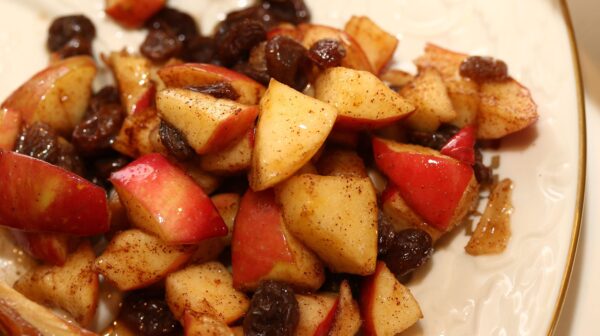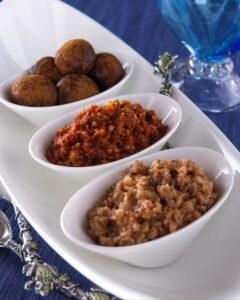Charoset Around the World

As we begin to prepare for Passover 2021, we think about the shopping list, cleaning and food preparation that goes into the seder meal. We asked several congregants to share their favorite charoset recipes from around the world and hope you’ll enjoy trying something new this year! Feel free to share your Passover photos with us by emailing templecommunications@tedallas.org. For more inspiration, check out Tablet Magazine. Passover begins at sundown on Saturday, March 27 and ends at sundown on Saturday, April 3.
Alex Smith: Traditional Charoset
Alex is involved in WRJ (Women of Reform Judaism) and can often be found baking at home or teaching a class for WRJ. Be sure to check out her dessert-making class on March 22 as we prepare for Pesach.
Tina Wasserman: Panamanian Jaroset Halek
“This recipe comes from Rita Sasso a Panamanian whose roots go back to Spain via Amsterdam and Curacao, a major Jewish colony in the 17th and 18th centuries. Rita and I became pen pals when I published a recipe in my Reform Judaism column that was given to me by a friend in Mexico. She recognized the recipe as her own. We have shared recipes ever since and here is one she gave me with her permission to publish.”
For more information and recipes from Tina Wasserman, check out her website.

Eli Cohn Wein: Persian Charoset
“A mostly overlooked tenet of the experience of eating charoset is that it’s supposed to feel decadent. Early practitioners of the Passover holiday dipped even their karpas (green herb) in the charoset – a nod to the wealthy Romans who never had a single dish without a sauce to slather over or dip into at one of their feasts. Reclining in your chair, seasoning already-flavorful and fresh vegetable with a rich and sweet sauce – this let all comers know: this meal was different; elevated.
Of course, the beloved chunky Ashkenazic apples-and-walnuts charoset of my youth gets it wrong in terms of emulating the roman sauces of old and in attempting to remind us of the mortar the Israelites used in their slave construction. Sephardic charosets, which generally incorporate dates and grind their mix finer, hit both of those symbolic notes, as well as, in my mind, hewing closer to the Talmud’s admonishment that charoset’s sweetness should have a minor sour note. The recipe, adapted from the Encyclopedia of Jewish Food, is a Persian recipe that, to me, is the platonic ideal of the dish.”
For more inspiration, follow @thejoyfulbelly on Instagram or visit Eli at the Dallas JCC.
Sophie Levy Zuckerman: Bubbie’s Charoset
“Funny story, when I went to Eric’s home in Atlanta for the first time it was Passover and making this charoset was the first time I spent one-on-one time with my mother-in-law!”
For more food inspiration, follow @thesophoodie on Instagram or visit www.sophoodie.com.
